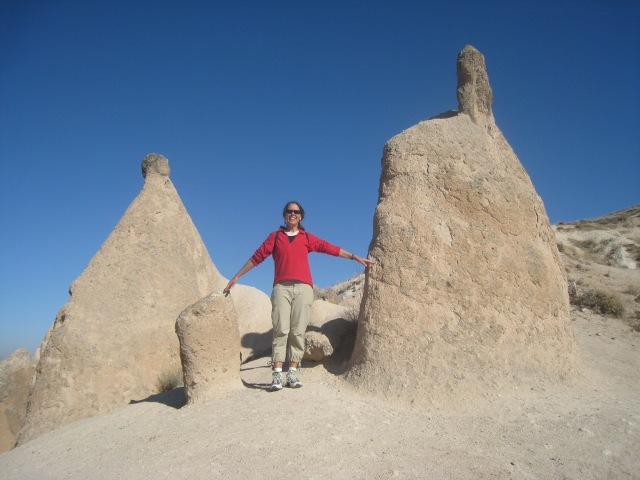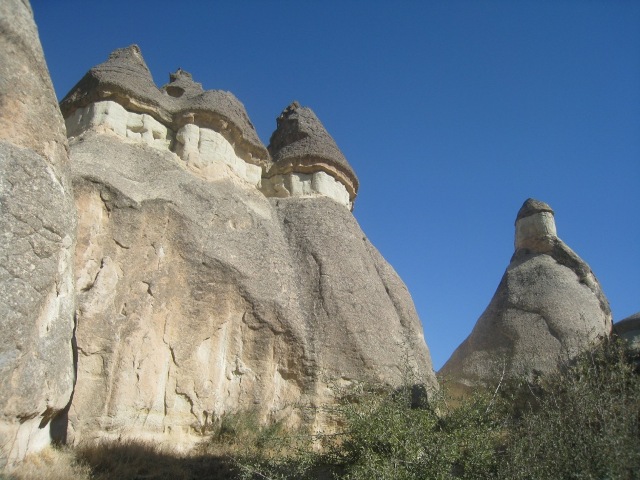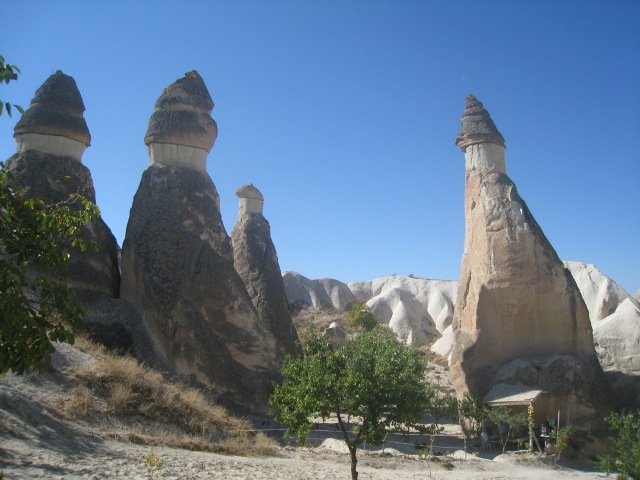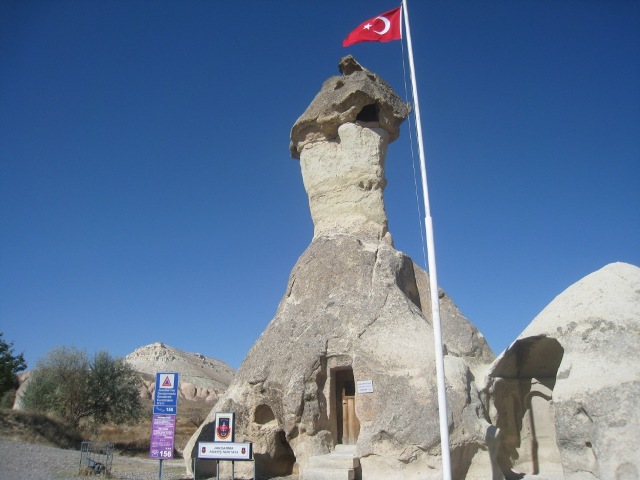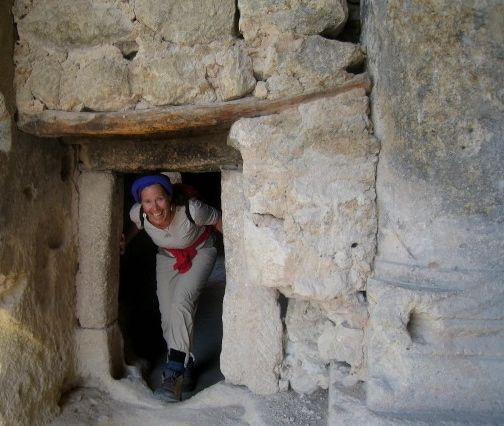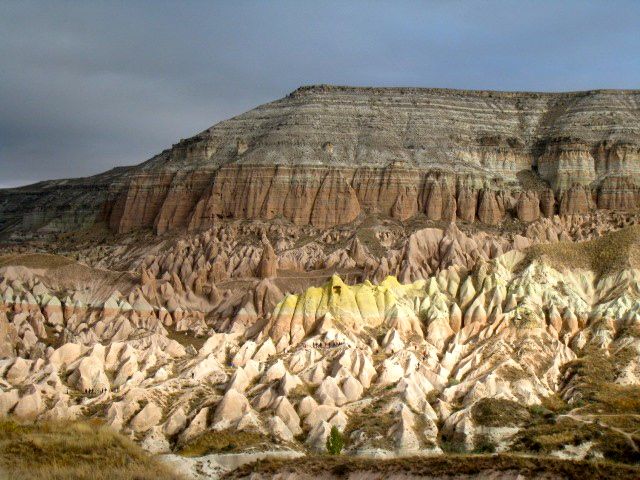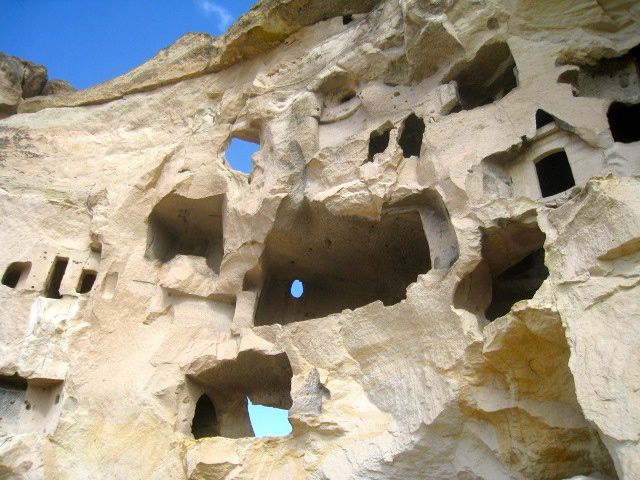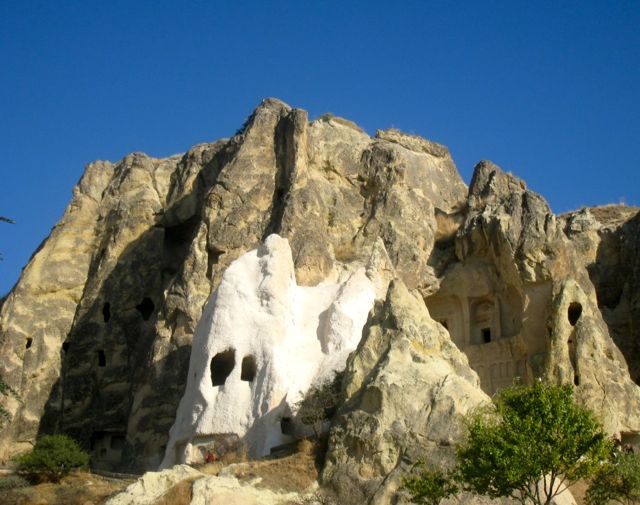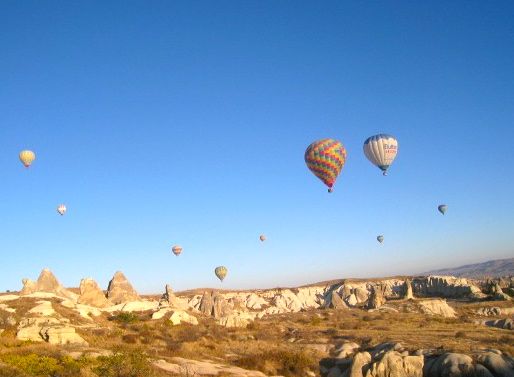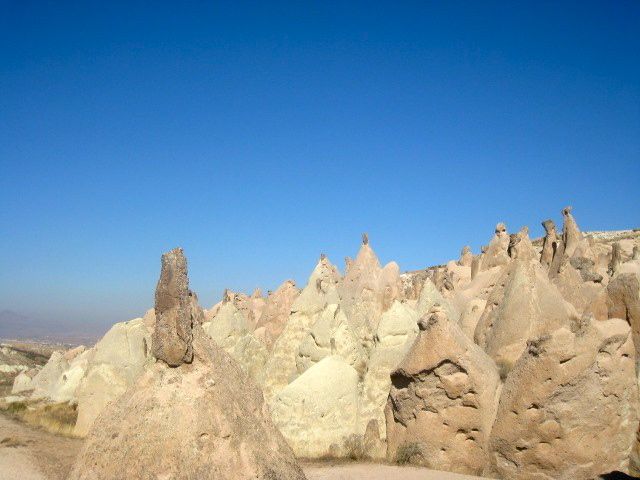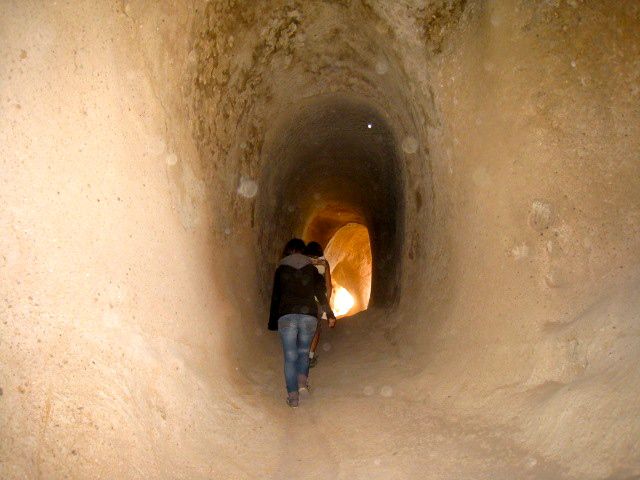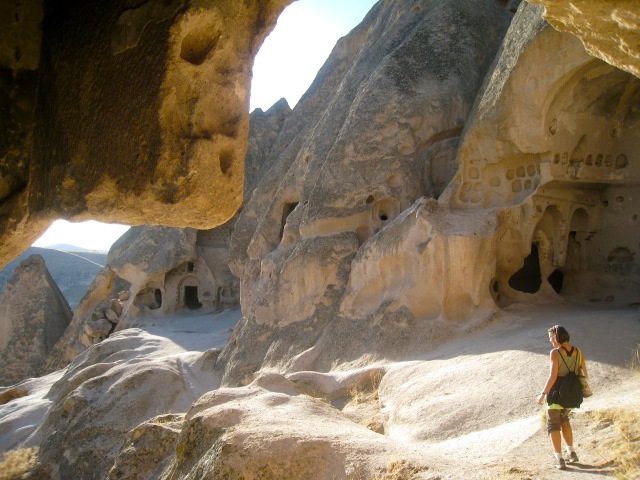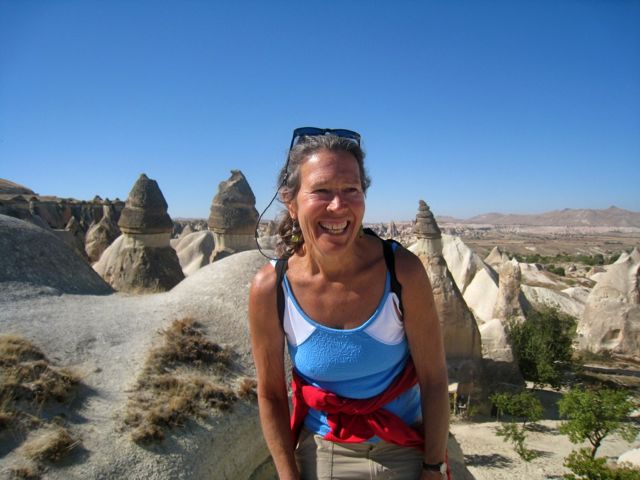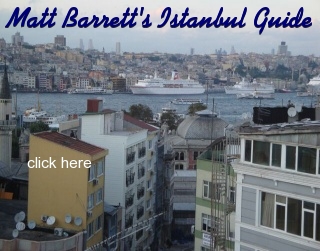Turkey Guide
Cappadocia
Cappadocia
|
|||
Rose Valley
Reaching the main dirt road, we came upon a motorcyclist selling fresh squeezed pomegranate juice. With saddlebags and bungee cords, he managed to carry a little table, juicer, cups, the fruit and even bottles of local wine and guide books. He’d ride up and down until he spotted susceptible tourists willing to buy his modestly overpriced products. Impressed by his clever enterprising spirit, Cat and I succumbed and bought a glass of “nar” juice. Fresh pomegranate juice, a rarity in U.S. juice bars, had already become a daily ritual during our Turkey trip. |
|||
Cavusin
Cavusin was once a Greek village. I don’t know when it stopped being inhabited by Greeks nor whether their absence was due to the Turkish government relocating the people because erosion and harsh weather made their rock-hewn homes unsafe, as the Turks maintain, or whether the residents were forced to leave, a tragedy that befell many Greeks in Turkey in the early 20th century. I suspect the village had a Greek name when Greeks lived there because this is the case with several other Greek towns in Cappadocia that were depleted of Greek families during the 1920s “population exchange,” and now bear Turkish names. Cavusin’s most famous feature is the 5th century Basilica of St. John the Baptist, one of the oldest churches in the region. The grandiose rock-cut structure looks utterly treacherous to enter; in the States it would be declared a lawsuit waiting to happen. But you can indeed follow a path up the cliff and explore various rooms, which is well worth the effort to see some marvelous religious carvings on the stone walls. |
|||
Goreme Open Air Museum
The cave churches, dating from the 10th, 11th and 12th centuries, are probably the most popular attraction in all Cappadocia. I’d say convenience of location right off the road is the chief reason. Setting aside my ornery observation, the church caves truly earned their World Heritage Site status. They are incredibly sculpted, almost to perfection, with vaulted domes, naves, apses, columns, altars and refectories – a word I confess I had to look up. A refectory is a communal dining hall in a religious house, college or other institution. In Goreme, refectory tables and benches were carved out of the rock and I doubt those anchorite diners used cushions. The scene brings to mind a stoic picnic site which is probably why an ungodly number of tourists seem compelled to sit down and pose with pretend cups raised in the air for a toast. By the way, anchorite is another new word I learned. It means “a person who has retired to a solitary place for a life of religious seclusion.” The Museum’s frescos are, of course, the site’s biggest draw since they are purportedly the finest in Cappadocia. Orthodox monks painted the churches in vivid colors depicting iconic images, such as, Mary with baby Jesus or St. George slaying the dragon. Some of the images are fascinating, even suggestively erotic. One particular cave is so spectacular that an additional entry fee is required, which we obligingly paid. It’s a mystery why it is called the Dark Church because the entirety of the walls and ceilings are painted in ultra-bright colors narrating the life story of Christ. Without a guide to explain the meaning of each figure, and not being Byzantine art buffs, after a while our eyes began to glaze over. The most striking cave in the entire complex is the stark white rock nunnery that pops out at you at the Museum’s entrance. I envisioned the triangular formation as the head of a hooded albino friar amongst his more somber brethren. As should be obvious by now, the very nature of Cappadocian topography stirs the imagination in provocative ways. It makes me wonder about a paradox: how did those rigidly ascetic anchorites relate to a terrain I behold as so fanciful, unorthodox and intoxicating to the imagination? |
|||
Hot Air Balloon
We are so thankful our captain had the integrity to wait. The next day the weather turned positively perfect. We took off just as the sun rose over Cappadocia’s otherworldly horizon. Minimal wind kept our balloon afloat for one solid hour. We were rewarded with tremendous aerial views of the freaky rock obelisks of Dervant Valley. When I reached 100, I quit counting the balloons, and realized I was witnessing a visible display of lots of money in the sky. The scene of dozens of circus-like hot air balloons floating over a fairy tale landscape lent the activity a fantasy quality. To clinch the romance of the venture, upon landing we were handed glasses of champagne. It did not go unnoticed by Cat and me that our $200 payment included the cost of this fancy finale, but it would have been churlish of us not to make a victory toast, and so we did, but we would have been much happier with a glass of fresh squeezed pomegranate juice. |
|||
Dervant Valley & Pasabag
OMG, Dervant Valley is so fun and funny and funky. It’s dazzling from the sky but you have to get down to earth to feel its capricious humor. A 45 minute walk away is Pasabag, another thoroughly entertaining site that to me evokes some kind of stomping grounds for gremlins. The “fairy chimneys” (called hoodoos out West) are comical rock spires, like minarets, some conspicuously phallic. Hilariously, the Pasabag police station is housed in one of these fairy chimneys. Although it is really really really hard to pick a favorite spot in Cappadocia, I’d have to say that Dervant Valley and Pasabag are my number one choice. |
|||
Ihlara Valley & Derinkuyu & Selime Monastery
En route to Ihlara Valley we made a pit stop at Derinkuyu to tour the largest excavated underground city in Turkey. In the 7th and 8th centuries, all these Christian hermits living in peaceful solitude fell under attack by invading Arabs. They fled their caves and set up complex underground communities all across Cappadocia, some of which were connected through a network of tunnels. Derinkuyu is phenomenal. It consists of eleven floors penetrating to a depth of 280 feet into the earth. The city accommodated between 35,000 and 50,000 people with homes, storages, stables, wine presses, schools, chapels and other features of city life. Only 10% of the site is accessible to tourists but that’s sufficient to get the picture of this awesome feat of human engineering. And, anyway, it gets tiring stooping through the long, low-ceilinged passageways connecting the rooms. Ihlara Valley is a ten-mile gorge cut into volcanic rock with a hiking trail pretty much hugging the Melendiz River from start to finish, one of the few hiking locales with a body of running water. The path is almost entirely flat with few obstacles and in some sections as wide as a car lane. This type of terrain encouraged Cat and me to get into our “New York City fast clip” mode for a hearty work-out. Gurcan, accustomed to casual hikers in Ilhara Valley, was thrilled, although he admitted our pace was a bit of a challenge. Most visitors do not walk the length of the valley primarily because the towering cliffs hold another attraction. Over one hundred archaic churches with frescos are carved into the rock. We were told some of the first Christians escaping Roman soldiers fled to Ilhara and created this unique historical treasury. I read somewhere that 80,000 people once lived in the valley and were housed in some 4,000 cave dwellings. During this period Ilhara was known as Peristrema. Reaching any one of the cave churches requires diverting from the path in a steep climb. Not that Cat and I are intimidated by ascents; the truth is, we were a little “churched out” and longed for some rigorous exercise.
Selime is home of the Selime Monastery, the largest rock-cut monastery of Cappadocia whose cathedral size church was carved by monks in the 13th century. We adored this site! We climbed up to its highest tiers and traipsed through all its rooms. The frescos and religious rock carvings were not as sensational as we had seen elsewhere but it was the multi-level configuration of the outcropping-turned-monastery that made us giddy. |
|||
Stray DogsCat and I saw plenty of stray dogs in Cappadocia and the most astonishing thing is how the Turks treat them. It isn’t just a matter of frequently observing restauranteurs, shop keepers and others tossing quality left-overs to stray dogs. While bicycling on a rural road, we saw a taxi driver take time to pull over to give some meaty bones to one stray dog who had decided to accompany us on our bike ride. I thought the driver was just throwing away his lunch and it was a coincidence that a dog was there to eat it. I asked him about this gesture and he replied that he always saves uneaten food to give to stray dogs and he saw this dog and intentionally stopped to feed it. And, it isn’t just a matter of a smart municipal policy wherein homeless dogs are spayed and green tags attached to their ears to indicate the operation, presumably so that untagged dogs can be identified and spayed too. Those two examples of charitable gestures would suffice to elevate the Turks to good citizens in our eyes. The uncanny thing is that we saw again and again Turkish people petting and giving love, care and genuine attention to stray dogs, whereas in most other societies ownerless animals are regarded as outcasts and treated with scorn, or worse, poisoned. Cat and I feel that the way the stray dogs are treated speaks volumes about the kindheartedness of the Turkish people. |
|||
Fond Memories
Well, maybe I should qualify my ringing endorsement of Cappadocia to say that if you love rocks and nature and hiking and quirky terrain and caves and mystical settlements and terrific food and friendly locals who are pleased to meet you even if you are a tourist --- well, then in that case, you better put Cappadocia on your bucket list. You can click on the above photos to see them full size. Cappadocia Travel Information
|
|||
Return to Matt's Turkey Index
Join Matt Barrett's Greece Travel Guides Group on Facebook for comments, photos and other fun stuff. If you enjoy this website please share it with your friends on Facebook and Google+

